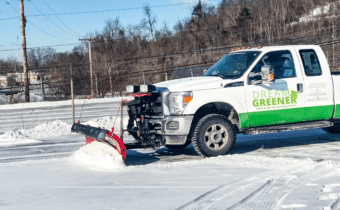As winter recedes and spring takes hold in Pittsburgh, our lawns come back to life – along with some unwelcome fungal guests. Lawn fungi are diseases caused by various molds and fungi that can turn patches of your beautiful grass brown, pink, or even covered in webby mold. They tend to thrive in the cool, damp conditions that are typical of a Pittsburgh spring. In fact, the mix of high humidity, mild temperatures, and frequent rain or morning dew in Pittsburgh creates the perfect environment for fungal growth.
In this blog post, we’ll explain what lawn fungi are and why they appear in spring, highlight the most common lawn diseases in our region, show you how to identify each by its visual symptoms, and share tips to prevent outbreaks through good lawn care practices. We’ll also explain how Dream Greener Lawn & Landscape treats these fungal issues professionally and why enrolling in a preventative lawn care program with us is a wise investment for homeowners in the Pittsburgh area.
Let’s dive into the world of lawn fungi and arm you with the knowledge to keep your turf healthy and fungus-free this spring!
What Are Lawn Fungi and Why Do They Occur in Spring?
Lawn fungi are microscopic organisms (molds and fungi) that live in the soil and thatch layer of your lawn. Under the right conditions, these fungi can infect grass plants and cause lawn diseases – those unsightly patches or discolorations you might see in your yard. Spring in Pittsburgh provides an ideal setting for many fungal diseases to flourish. Cool nights, rainy or humid weather in late spring, and soils recovering from winter can all stress your grass and activate fungal spores that were lying dormant over the winter.
During winter, some fungi survive in dead grass tissue or under snow as spores or mycelium (a fungal growth form). When warmer spring weather arrives along with rainfall, the fungi wake up and start spreading on your grass blades. Lawns that are weak or stressed – for example, from poor nutrition or leftover winter damage – are especially vulnerable. But even well-kept lawns can get fungal diseases if the weather favors the fungus. Pittsburgh’s spring often has periods of cool, damp conditions followed by warmer days, which is a recipe for certain lawn fungi to take hold.
The good news is that most lawn fungi can be managed or prevented with proper lawn care. By understanding why fungi occur, you can take steps to make your lawn less inviting to disease. In the next sections, we’ll cover the most common spring lawn fungal diseases in the Pittsburgh area – including red thread, brown patch, dollar spot, and snow mold – and how to identify and deal with each of them.
Red Thread: Pink Patches in Cool, Damp Lawns
Red thread fungus appears as pinkish-red, threadlike strands on grass blades and can create patches of discolored, tan turf. Red thread is a very common lawn fungus in Pennsylvania and often one of the first diseases you might notice in spring. It’s caused by a fungus (Laetisaria fuciformis) that thrives in cool (60–75°F), humid weather and in nutrient-poor turf. During rainy periods in late spring and early summer, red thread becomes one of the most common lawn diseases in Pennsylvania. It tends to attack cool-season grasses like perennial ryegrass and fine fescue (both common in Pittsburgh lawns), especially if your lawn has low nitrogen fertility.
How to Identify Red Thread
You’ll recognize red thread by the distinctive pink or reddish threads that bind together grass blades. In early stages, you might see small patches of grass that look water-soaked or darkened. As it progresses, irregular patches of grass turn light brown or tan and you’ll notice thin red or pink fibers (they look like bits of red thread or string) extending from the grass blades. These threads are actually fungal mycelium. A red thread patch can be a few inches to a couple of feet wide. The affected grass blades may dry out, giving the patches a straw-colored, ragged look. Importantly, red thread typically does not kill the grass roots – it mainly affects the leaves – so the lawn can recover with proper care.
Prevention and Treatment of Red Thread
Red thread often signals that your lawn is hungry for nutrients. The fungus is commonly seen in lawns that haven’t received enough nitrogen fertilizer. To prevent red thread, make sure your lawn feeding schedule is on track – a balanced spring fertilizer application can strengthen your grass and make it less susceptible. Other cultural practices to prevent and minimize red thread include:
- Mowing regularly at the correct height. Keep grass around 3 inches tall for most cool-season species, and mow frequently enough that you’re not removing more than one-third of the blade at a time. This avoids stressing the grass. Always bag or rake heavy clippings if disease is present, to avoid spreading spores.
- Improving airflow and drainage. Red thread loves lingering moisture. Aerate compacted areas to help water drain and dethatch if thatch is over 1/2-inch thick. Better airflow and less thatch make conditions less favorable for the fungus.
- Watering in the morning. If your lawn needs water, do it early in the day so grass blades dry by evening. Avoid nighttime watering which leaves the lawn damp overnight – a condition red thread enjoys.
- Proper fertilization. An appropriate fertilization program will ensure your grass has the nutrients it needs. Lawns with adequate nitrogen are much less likely to develop red thread. (Tip: Dream Greener’s lawn care programs include timed fertilizer treatments to keep your grass well-nourished.)
Usually, red thread will clear up on its own once temperatures warm and you correct any nutrient deficiencies. The grass will grow out of the damaged blades. You can speed recovery by lightly raking the patches to stimulate new growth and applying a nitrogen-rich fertilizer to help the lawn “grow out” of the disease.
Professional Treatment: If red thread outbreaks are severe or persistent, Dream Greener can apply a fungicide to stop the fungus in its tracks. Our team will identify the disease and may use a targeted fungicide treatment as a last resort to eliminate red thread– typically, we focus on improving the lawn’s health first so it can fight off the disease naturally.
Check out additional photos and information on Penn State’s Red Thread page.
 Brown Patch: Summer’s Big Brown Circles
Brown Patch: Summer’s Big Brown Circles
Brown patch often appears as large, round patches of brown, dead-looking grass, sometimes with a darker “smoke ring” at the edge. Brown patch is another lawn fungus that can affect Pittsburgh lawns, although it usually shows up as the weather gets warmer. It’s caused by Rhizoctonia solani, a fungus that thrives in hot, humid conditions. Brown patch is a major summer lawn disease in our region, often becoming a problem in July and August. However, the groundwork for brown patch can start in late spring when nights get warmer and humidity rises. Lawns with tall fescue or ryegrass are commonly affected, and it can also hit Kentucky bluegrass under the right conditions.
How to Identify Brown Patch
As the name suggests, brown patch appears as brown or yellow-brown patches in the lawn. These patches are typically circular or roughly circular, and can be quite large – from 6 inches up to several feet in diameter. A classic symptom (especially in the morning when there’s dew) is a dark gray or purple border (a “smoke ring”) around the patch, which is the advancing edge of the fungus. The grass within the patch may look scorched, wilted, or matted, and if you touch it early in the day it might feel slimy due to the fungus activity overnight. Sometimes, if brown patch has been active for a while, the center of a patch may recover and green back up, leaving a ring of dead grass – this is often called a “frog-eye” pattern. Unlike red thread, brown patch can kill the grass blades and even crowns quickly in severe cases, so large areas can thin out.
Brown patch typically erupts when daytime temperatures are above 80°F and nights stay above 65°F with high humidity. Heavy rainfall or watering in that kind of weather can trigger an outbreak literally overnight. If you see rapid, large brown circles in warm weather, brown patch is a prime suspect.
Prevention and Treatment of Brown Patch
Because brown patch favors hot and wet conditions, the key to prevention is reducing lawn moisture and heat stress in summer. Here are some tips to keep brown patch at bay:
- Water deeply, but infrequently, and in the early morning. Avoid watering in late afternoon or evening; watering in the morning gives grass time to dry before night. Also, don’t overwater – you want to keep the soil moisture even, but the surface should not stay soggy. Overly wet soil and thatch create a perfect breeding ground for brown patch.
- Improve airflow and drainage. Much like with red thread, aeration can help here. Good airflow dries the grass blades and cools the lawn. If you have areas that stay muggy or have poor air circulation (for example, a fenced corner or under dense trees), consider trimming vegetation or running a fan/sprinkler briefly to move air on extremely humid nights. (Our Dream Greener experts can identify trouble spots and recommend solutions like pruning or landscape changes to improve airflow.)
- Mow at the proper height. Slightly taller grass can sometimes encourage more airflow at the soil level. However, avoid letting the lawn get excessively long and lush during peak humid summer – very dense growth can hold moisture. Keep mower blades sharp to minimize frayed grass tips (frayed tips hold water and invite disease). Remove clippings if disease is present.
- Avoid over-fertilizing in late spring/summer. While grass needs nutrients, too much nitrogen in late spring can produce lush growth that is tender and prone to fungus in summer. Follow a balanced fertilization schedule (Dream Greener’s lawn care program times fertilizer applications to seasonally appropriate amounts).
- Reseed with resistant grass varieties. If your lawn has recurring brown patch, we might suggest overseeding with grasses that have better brown patch resistance (for instance, certain turf-type tall fescues). A diverse mix of grass types can also reduce the impact.
Once brown patch strikes, act quickly. At home, there’s not much you can do to cure it aside from waiting for drier weather and helping the lawn recover. You can gently rake out dead material in patches once the fungus subsides and then overseed any large dead areas in early fall.
Professional Treatment: Dream Greener offers fungicide treatments that can halt brown patch if applied early in the disease cycle. We use fungicides as needed – often as a preventive measure for lawns with a history of brown patch or when forecasts call for extended hot, wet periods. Our technicians will apply a fungicide that targets Rhizoctonia to stop the spread and protect unaffected grass. Keep in mind, fungicides work best when applied at the first sign of disease, so don’t hesitate to call us if you see brown patches forming.
Learn more about Brown Patch on Penn State’s page.
 Dollar Spot: Small Spots that Can Merge into Large Blights
Dollar Spot: Small Spots that Can Merge into Large Blights
Dollar spot often starts as small, round, straw-colored spots about the size of a silver dollar, which can merge into larger patches if not addressed. Dollar spot is a lawn fungus that causes small bleached patches on turf. It’s caused by the fungus Clarireedia jacksonii and is common on home lawns, golf courses, and parks. In Pittsburgh and southwestern PA, dollar spot tends to show up in late spring through early fall, especially during periods of warm days, cool nights, and high humidity. It can affect many grass types, including Kentucky bluegrass, perennial ryegrass, and fine fescue, which are typical in our lawns.
How to Identify Dollar Spot
This disease gets its name because the early symptoms are round, tan spots about the size of a silver dollar (2–3 inches). On a home lawn mowed at normal heights, these spots might be a bit larger, around 2–5 inches across. At first, you might just notice small light brown patches dotting an otherwise green lawn. When conditions are favorable (warm and moist), multiple spots can grow together and form irregular larger patches of straw-colored grass. If you look closely at individual grass blades in an infected area, you may see tan lesions with reddish-brown borders, often giving an “hourglass” shape across the blade. Sometimes you might also notice a cobweb-like mycelium on the grass in the early morning before the dew dries, similar to other fungi.
Dollar spot often strikes lawns that are under-fertilized (again, low nitrogen makes grass more susceptible) and those that stay damp overnight. It can reoccur multiple times in a season if not addressed, since the fungus can remain in the thatch.
Prevention and Treatment of Dollar Spot
Preventing dollar spot is very similar to preventing red thread and other foliar diseases:
- Maintain adequate nutrition. Ensure your lawn gets enough nitrogen through the growing season. Penn State Extension notes that dollar spot tends to be worse on nutrient-starved turf, so a proper fertilization schedule will greatly reduce its incidence. Don’t overdo it all at once, but slow-release fertilizers applied by professionals (like our Dream Greener slow-release treatments) will keep your lawn fed and less vulnerable.
- Water wisely. Water in the early morning hours so that grass blades dry quickly. Avoid daily shallow watering – instead water deeply 1–2 times per week. This practice reduces the total time grass stays wet and strengthens roots, making the lawn more resilient.
- Mow and bag if needed. Mowing at 3–3.5 inches is generally ideal for our cool-season grasses. During a dollar spot outbreak, consider bagging clippings in the affected areas to prevent clippings with fungus from sitting on the lawn. Always clean your mower blades after mowing a diseased area so you don’t spread it elsewhere.
Reduce thatch and improve airflow. Thatch (a layer of dead grass material on the soil surface) can harbor fungal spores. Core aeration and occasional dethatching help keep thatch under control and also improve air circulation in the turf canopy, making conditions less favorable for fungi like dollar spot.
If you catch dollar spot early, often a boost of fertilizer and proper watering will allow your grass to outgrow the damage. The surrounding healthy grass can fill in the small spots. For persistent cases, Dream Greener can apply specialized fungicides that target dollar spot’s pathogen.
Professional Treatment: We may implement a preventative fungicide schedule on lawns that perennially suffer from dollar spot, especially if you have important events or just want peace of mind that your lawn will stay picture-perfect. Our team selects fungicides that provide a protective barrier and suppress the fungus for up to a few weeks per treatment. Combining these treatments with cultural improvements (like aeration and fertilization) yields the best results.
Learn more on Penn State’s Dollar Spot page.
 Snow Mold: The After-Effect of Winter Snows
Snow Mold: The After-Effect of Winter Snows
Snow mold appears as circular patches of matted, dead-looking grass often covered in a white or gray cottony fungus when the snow melts. Snow mold is a lawn disease that becomes visible in early spring right as the snow is melting. Pittsburgh winters can be cold and snowy, and if your lawn was under snow for a long time, you might find these moldy patches when things thaw out. Snow mold is caused by fungi that grow under the snow cover during winter. There are two main types: gray snow mold (Typhula blight) and pink snow mold (Microdochium patch). Gray snow mold typically requires prolonged snow cover to develop, whereas pink snow mold can occur even without snow if the weather is cold and wet. Both can show up as the snow recedes.
How to Identify Snow Mold
Snow mold patches are usually circular and range from a few inches to a foot or more in diameter. The grass within these patches is dead, flattened, and often has a whitish, gray, or even pink fuzzy growth on it. It might look like someone draped spider webs or cotton candy over the grass. Gray snow mold tends to appear white to gray in color, sometimes with tiny reddish-brown specks (fungal survival structures called sclerotia) on the dead grass. Pink snow mold can have a pinkish tinge on the moldy growth. The affected areas are usually in shaded or poorly drained spots, or where snow piled up deeply (for example, along driveways where snow was shoveled). Often, yards that didn’t get a final fall mowing or had lots of leaf debris are more prone – the extra material gets matted under snow and fuels the fungus.
The good news is that snow mold mostly damages the grass blades, not the roots, so lawns can recover with some TLC. You’ll know you had snow mold if those matted patches are present, but as temperatures warm above 45–50°F consistently, the fungus stops growing.
Prevention and Treatment of Snow Mold
The best defense against snow mold starts before winter arrives, because once you see it in spring, the outbreak has already run its course. To prevent snow mold in the first place:
- Fall lawn care is key. In late fall, do a final mowing to leave grass short going into winter (around 2 to 2.5 inches). Remove all fallen leaves and thatch so nothing is left to mat down the turf. Avoid heavy nitrogen fertilization late in the fall – you don’t want overly lush growth when snow falls, as it’s more susceptible to mold.
- Manage snow cover if possible. Obviously, we can’t control the snow, but if a huge snow pile is sitting on one part of the lawn (from shoveling or plowing), try to spread it out to help it melt evenly. Snow mold tends to be worse when snow sticks around for a long time on unfrozen ground. If we get an early snow that then melts, and then more snow, that freeze-thaw can also encourage mold.
- Consider a preventive fungicide. For lawns that have had severe snow mold in the past (or high-value lawns like athletic fields), applying a fungicide in late fall (before the first heavy snowfall) can prevent snow mold development. Dream Greener offers this service for customers who need it – usually as part of our fall lawn care program for disease prevention.
If you do find snow mold in spring, don’t panic. Once the lawn dries out a bit, gently rake the matted areas with a leaf rake. This fluffing allows air to circulate and helps the grass stand back up. Often, the grass will begin to grow again and the patches will disappear over a few weeks. If any patches are very dead (deep thatch and mold killed the crowns), you may need to rake out the dead material and add some seed to those spots. A light fertilization in spring will also help the lawn recover and fill in. Typically, we do not need to apply fungicides in spring for snow mold because the outbreak is already done – it’s about recovery at that point.
Dream Greener’s crews handle snow mold by including it in your spring lawn analysis. We check for any winter damage like snow mold and will perform the necessary first aid – raking, aerating, and overseeding as needed – to restore those areas. We can also advise on adjustments in fall care for next year to avoid recurrence.
Learn more about Grey Mold and Pink Mold on Penn State’s website.
Less Common (But Still Serious) Lawn Fungal Diseases in Pittsburgh
 Anthracnose: A Springtime Disease That Mimics Drought
Anthracnose: A Springtime Disease That Mimics Drought
Anthracnose, caused by the fungus Colletotrichum cereale, is a stealthy lawn disease that often begins in early spring and can worsen through summer—especially on stressed turfgrass like annual bluegrass (Poa annua) and Kentucky bluegrass, both commonly found in Pittsburgh lawns. It often shows up following cool, wet weather or after an extended winter where turf hasn’t fully recovered.
How to Identify Anthracnose
Anthracnose can present in two ways: as a leaf blight, affecting the grass blades, or as basal rot, which targets the plant’s crown and roots. You’ll first notice yellowing or thinning turf in patches, especially in sunny or compacted areas. As it progresses, patches can turn straw-colored and may appear sunken. A key symptom is black, hair-like fungal structures (called acervuli) at the base of affected blades—visible under a magnifying glass. These signs often mimic drought stress, which is why Anthracnose is frequently misdiagnosed by homeowners.
Prevention and Treatment of Anthracnose
Anthracnose usually appears on lawns that are already weakened due to low mowing height, compaction, low nitrogen, or poor drainage. To prevent it:
- Mow at the right height: Avoid scalping the lawn. Keep your mower set to 3–3.5 inches for most cool-season grasses.
- Improve soil health: Aerate compacted soil and ensure proper drainage.
- Feed properly: Fertilize moderately in spring and avoid pushing lush growth with high nitrogen midsummer. A balanced feeding schedule is essential.
- Water deeply and early in the day to reduce prolonged leaf wetness.
Professional Treatment: For severe cases, Dream Greener can identify anthracnose during your lawn inspection and apply targeted fungicides to stop its spread. However, we often find that correcting environmental conditions and implementing core aeration and a good fertilization plan is enough to help your lawn bounce back and prevent future outbreaks.
Learn more about Anthracnose on Penn State’s site.
 Pythium Blight: Rapid-Spread Danger in Hot, Humid Conditions
Pythium Blight: Rapid-Spread Danger in Hot, Humid Conditions
Pythium blight, sometimes called “grease spot” disease, is a particularly aggressive turf disease that thrives in hot, humid, and wet conditions—often during late spring and early summer storms in Pittsburgh. Caused by Pythium aphanidermatum and related species, this disease can destroy grass quickly and spreads like wildfire through over-irrigated or poorly draining lawns.
How to Identify Pythium Blight
The hallmark of Pythium blight is its rapid development and greasy, water-soaked appearance. Affected turf may appear dark, wilted, and matted. You may even see cottony white growth in the early morning, particularly when dew is present. As it progresses, patches coalesce into large, irregular dead zones that seem to spread overnight.
Pythium thrives in low-lying areas, compacted soils, or turf with poor airflow. It’s especially damaging on newly seeded lawns or over-fertilized grass.
Prevention and Treatment of Pythium Blight
Because of its speed, early intervention is critical. Pythium doesn’t respond to typical turf fungicides, so specific treatments are needed. Prevention is key:
- Improve drainage and airflow: Core aeration and dethatching are critical in areas prone to waterlogging.
- Avoid evening watering: Irrigate early in the morning only when necessary.
- Limit nitrogen in humid weather: Avoid high nitrogen applications just before a forecasted heatwave or rainy spell.
- Clean your mower blades: Pythium spores can be spread through equipment, so sanitation is crucial.
Professional Treatment: Dream Greener uses specialty fungicides formulated for water mold pathogens like Pythium. We’ll identify high-risk areas of your lawn and apply these treatments proactively during peak risk windows. Preventive applications, drainage improvements, and aeration services are often bundled into our lawn care programs for vulnerable properties.
Preventing Lawn Fungal Diseases with Proper Lawn Care
While each fungus has its favorite conditions, the same healthy lawn practices go a long way in preventing all types of fungal diseases. By being proactive with lawn maintenance, you’ll create an environment where disease is much less likely to take hold. Here are some cultural practice tips that are especially effective for Pittsburgh lawns:
- Mow Regularly at the Right Height: Follow the rule of thumb to mow frequently enough that you never remove more than one-third of the blade length at once. For most Pittsburgh cool-season lawns, that means keeping the mower set around 3 to 3.5 inches. Regular mowing promotes a dense, even turf and prevents overly long grass that can mat down and trap moisture. Always use a sharp mower blade for a clean cut (dull blades tear the grass and make it more vulnerable to disease entry). Need help? Dream Greener offers lawn mowing service in the Pittsburgh area.
- Water Wisely: Water in the early morning hours (around 5am–9am) so that the grass has all day to dry. Deep, infrequent watering is best – for example, giving your lawn 1 inch of water once or twice a week, rather than a little every day. This encourages deep roots and avoids constant dampness on the surface. As Penn State Extension experts remind us, prolonged wetness from dew or irrigation can encourage fungal development. If we’re getting plenty of spring rain, you may not need to water at all until weather dries.
- Feed Your Lawn and Amend Soil: A well-fed lawn is a stronger lawn. Fertilize according to your lawn’s needs – typically a feeding in spring, early summer, late summer, and fall for cool-season grass. Balanced fertilizer provides nitrogen and other nutrients that keep your grass thick and vigorous, which helps it resist infections. Soil pH also matters; most turf diseases prefer either very acidic or very alkaline conditions. Dream Greener conducts soil tests and can add lime or other amendments to keep your soil in the optimal pH range for turfgrass, which indirectly deters some diseases.
- Aerate and Dethatch: Core aeration (punching small holes in the soil) each year or every other year relieves soil compaction and increases airflow to the roots. Better airflow and drainage mean your lawn surface dries quicker after rain, denying fungi the moisture they crave. Aeration also helps reduce thatch. Keep thatch (the layer of dead organic matter) under about 1/2 inch thick. If thatch is excessive, consider power raking or dethatching in the fall. Less thatch = fewer places for fungus to hide and overwinter.
- Overseed Thin Areas: Thinner grass areas are prime targets for weeds and diseases. By overseeding your lawn (spreading new grass seed) annually or as needed, you maintain a dense turf coverage. A dense lawn not only looks great but also creates a micro-environment that’s less favorable to fungi (and leaves less open space for spores to land and spread). Our Dream Greener team often mixes in disease-resistant grass varieties when overseeding to bolster your lawn’s natural defenses.
Clean Up Debris: Remove fallen leaves promptly in autumn and clear away any grass clippings or debris that could harbor fungi. Many pathogens, like the snow mold fungus, can survive on dead plant matter. A thorough fall cleanup and even a winter/early spring cleanup if you see leftover debris will reduce the chance of disease carryover.
By following these practices, you’re essentially “vaccinating” your lawn against many common diseases. It’s much easier and cheaper to prevent fungi with good maintenance than to cure a full-blown outbreak later.
How Dream Greener Treats Lawn Fungal Issues (And Why Prevention Pays Off)
At Dream Greener Lawn & Landscape, we take a comprehensive approach to lawn fungus control. Our philosophy is based on three steps: Select, Change, and Attack:
- Select the Right Grass & Care Program: We start by choosing (or recommending) disease-resistant grass varieties for your lawn when seeding. A diverse mix of grass types increases the odds that your lawn can survive a fungus attack – some grasses in the mix will resist what others are susceptible to. We also tailor a lawn care program for you that “selects” the right balance of fertilization, weed control, and maintenance to keep your turf healthy year-round.
- Change the Environment: Before jumping to chemicals, our team will try to modify the lawn’s environment to discourage fungal growth. That might mean improving irrigation practices, correcting drainage issues, adjusting mowing height or frequency, trimming surrounding landscaping for better airflow, or adjusting fertilizer timing and amounts. These cultural changes often significantly reduce disease pressure. For example, if we notice your lawn is frequently getting red thread, we’ll likely boost your fertilization schedule slightly and ensure you’re watering correctly, since that often solves the issue.
- Attack (Apply Fungicides if Necessary): Fungicides are our last resort (but we’re fully prepared to use them when needed). We use professional-grade turf fungicides that can either coat the grass blades (contact fungicides) or be absorbed into the plant (systemic fungicides). The choice depends on the disease and situation. Contact fungicides act quickly and are good for stopping surface-level diseases like red thread and dollar spot, but they don’t protect new growth. Systemic (penetrant) fungicides can protect the lawn for longer periods (2-4 weeks) and can knock out fungi that have gotten into the plant tissues. Our lawn care experts are trained to identify exactly which fungus is attacking your lawn so we can choose the appropriate fungicide and treatment schedule. Proper identification is critical – we won’t treat dollar spot and brown patch exactly the same, for instance, as they require different products and timing.
When you partner with Dream Greener, you gain peace of mind that any sign of disease will be caught early and addressed. Often, our technicians will spot subtle symptoms during your regular lawn service visits – like the first hints of red thread or dollar spot – and will notify you with recommended next steps. We can apply a preventative fungicide application if conditions are ripe for a known issue (for example, an application in late spring if we anticipate a bad dollar spot season, or in late fall for snow mold prevention). By being proactive, we stop problems before they escalate.
The Value of a Preventative Lawn Care Program
Enrolling in a preventative lawn care program with Dream Greener is a wise investment for any Pittsburgh homeowner who loves their lawn. Think of it as insurance for your grass. Instead of reacting to brown patches or mold after they’ve already damaged your turf, a preventative program keeps your lawn in optimal health and catches issues early. Our annual programs typically include fertilization, weed control, aeration, and monitoring for pests and diseases. By keeping your lawn thick, fed, and properly watered and mowed (we offer mowing services too), we dramatically reduce the likelihood of fungal outbreaks in the first place.
When fungal diseases do occur, customers in our program benefit from prompt treatment. We stand by our work – if you’re on a full program and a fungus pops up, we’ll take care of it, often at little to no additional cost. This saves you money long-term; severe lawn diseases can kill large areas of turf that then might need costly renovation or reseeding. It’s far more economical to invest in prevention than to replace an entire lawn or fight a rampant disease later. Plus, a well-maintained, disease-free lawn enhances your home’s curb appeal and your enjoyment of your outdoor space. It’s an investment that pays off in property value and in the simple pleasure of having a lush, green lawn without the worry of ugly fungal spots.
Ready for a Healthier Lawn This Spring? Schedule Your Lawn Analysis Today!
Your lawn is meant to be enjoyed – not battled over with brown patches and mysterious molds. The team at Dream Greener Lawn & Landscape is here to help you prevent and conquer any lawn fungus that dares to invade your yard. From early spring red thread to summer brown patch to lingering snow mold, we have the local expertise, professional products, and passion for turf care to restore your lawn’s health and beauty.
Don’t let lawn diseases run rampant. Get a head start on a healthy lawn by contacting Dream Greener for a comprehensive spring lawn analysis. We’ll inspect your grass, identify any signs of fungus or other issues, and craft a customized fungal treatment and prevention plan for your property. This spring, take action and protect your lawn before problems arise. Call us or contact us online to schedule your spring lawn analysis and fungal treatment plan today, and enjoy a green, disease-free lawn all season long! We look forward to helping you dream greener and achieve a fungus-free lawn in Pittsburgh, PA.
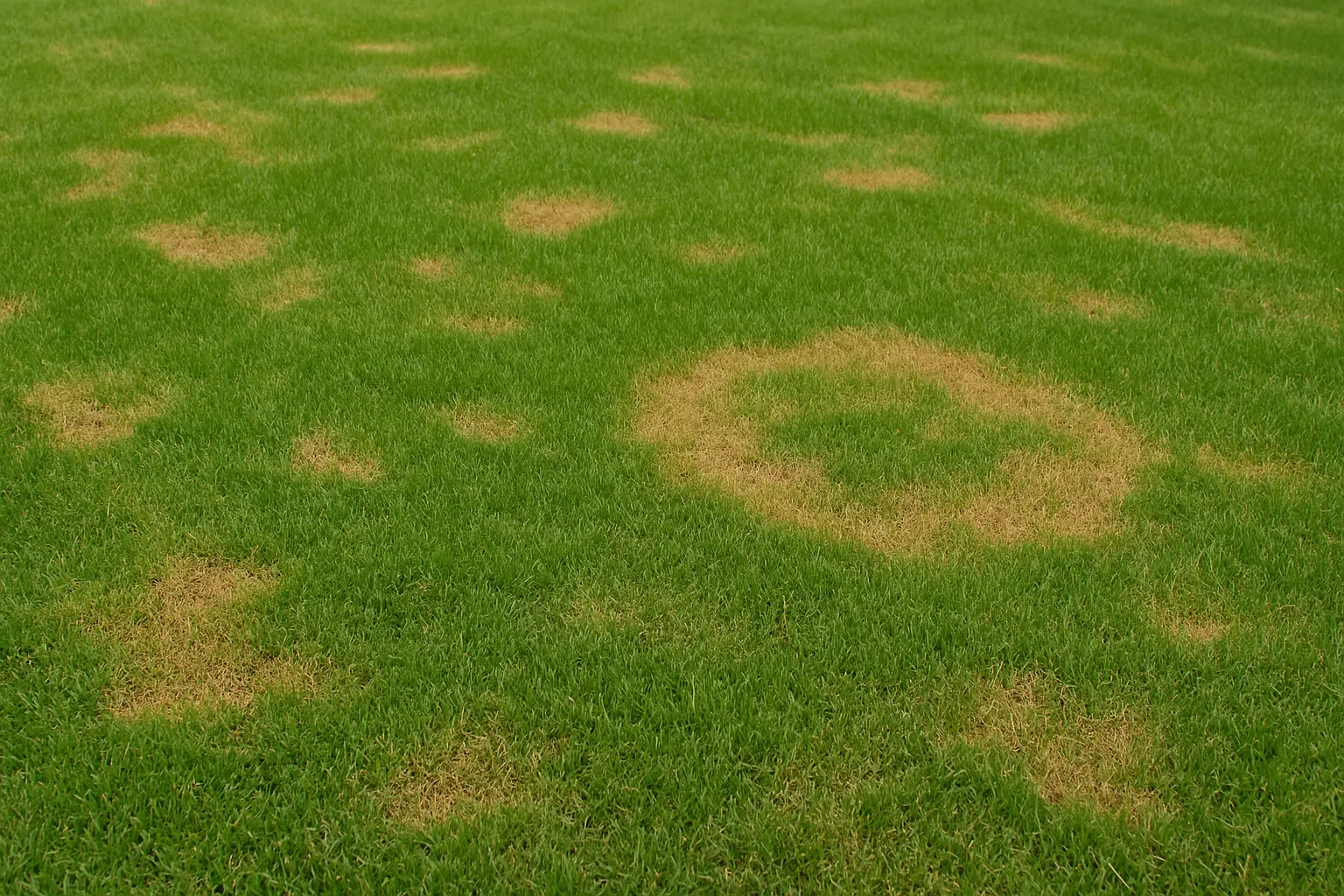 Brown Patch: Summer’s Big Brown Circles
Brown Patch: Summer’s Big Brown Circles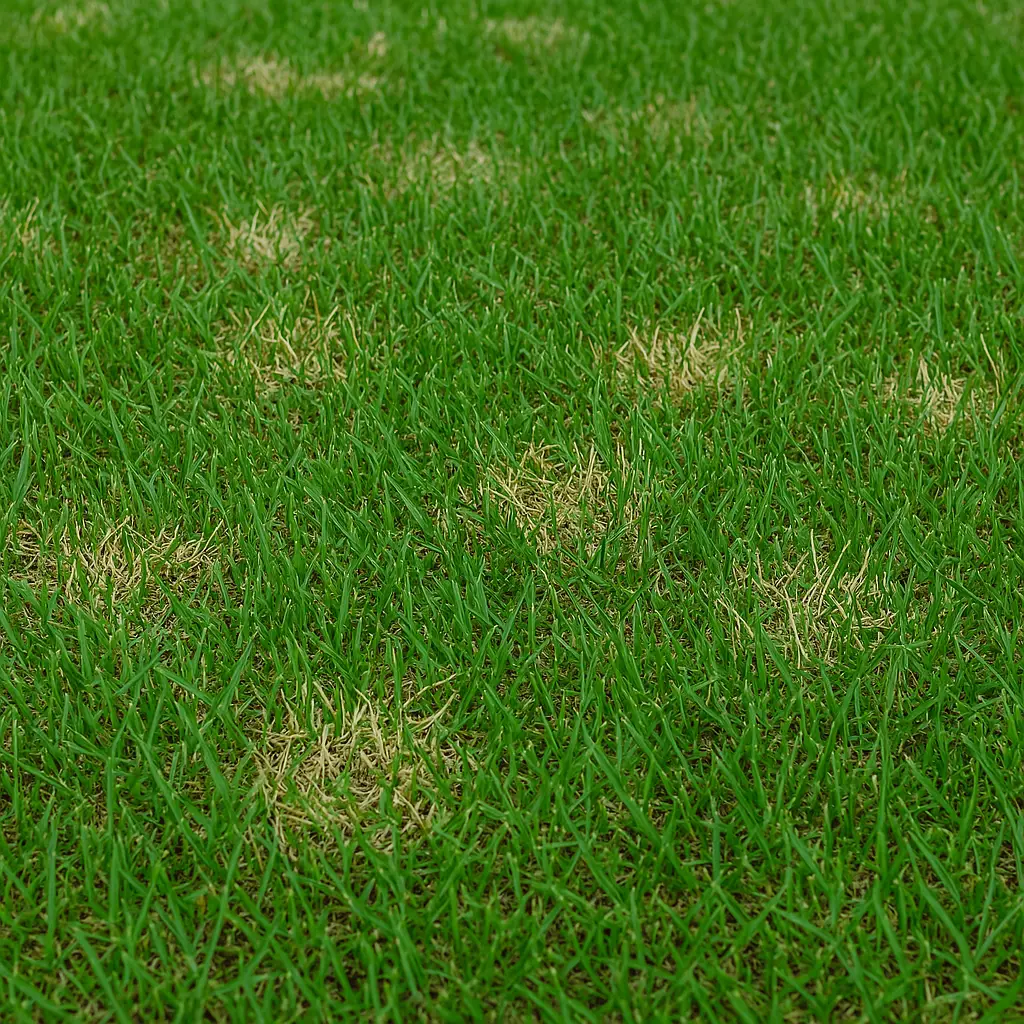 Dollar Spot: Small Spots that Can Merge into Large Blights
Dollar Spot: Small Spots that Can Merge into Large Blights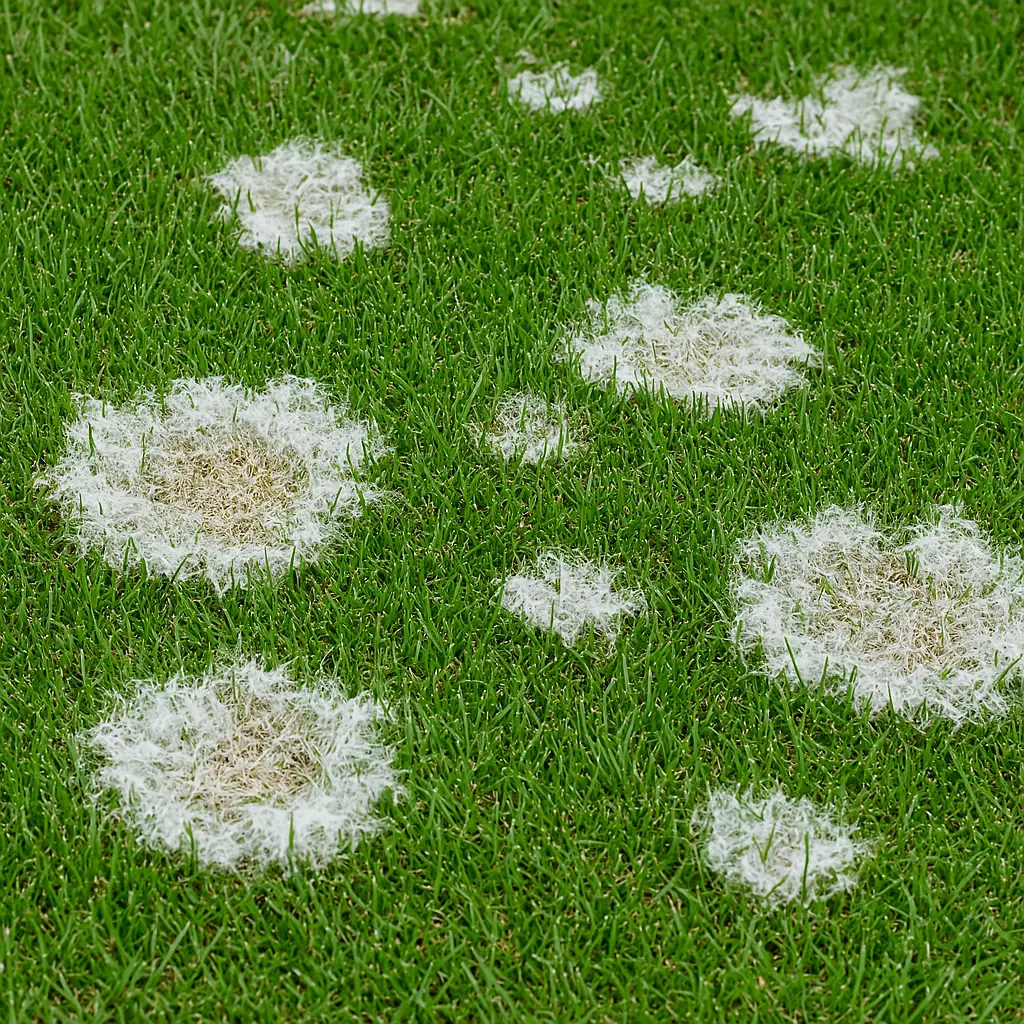 Snow Mold: The After-Effect of Winter Snows
Snow Mold: The After-Effect of Winter Snows Anthracnose: A Springtime Disease That Mimics Drought
Anthracnose: A Springtime Disease That Mimics Drought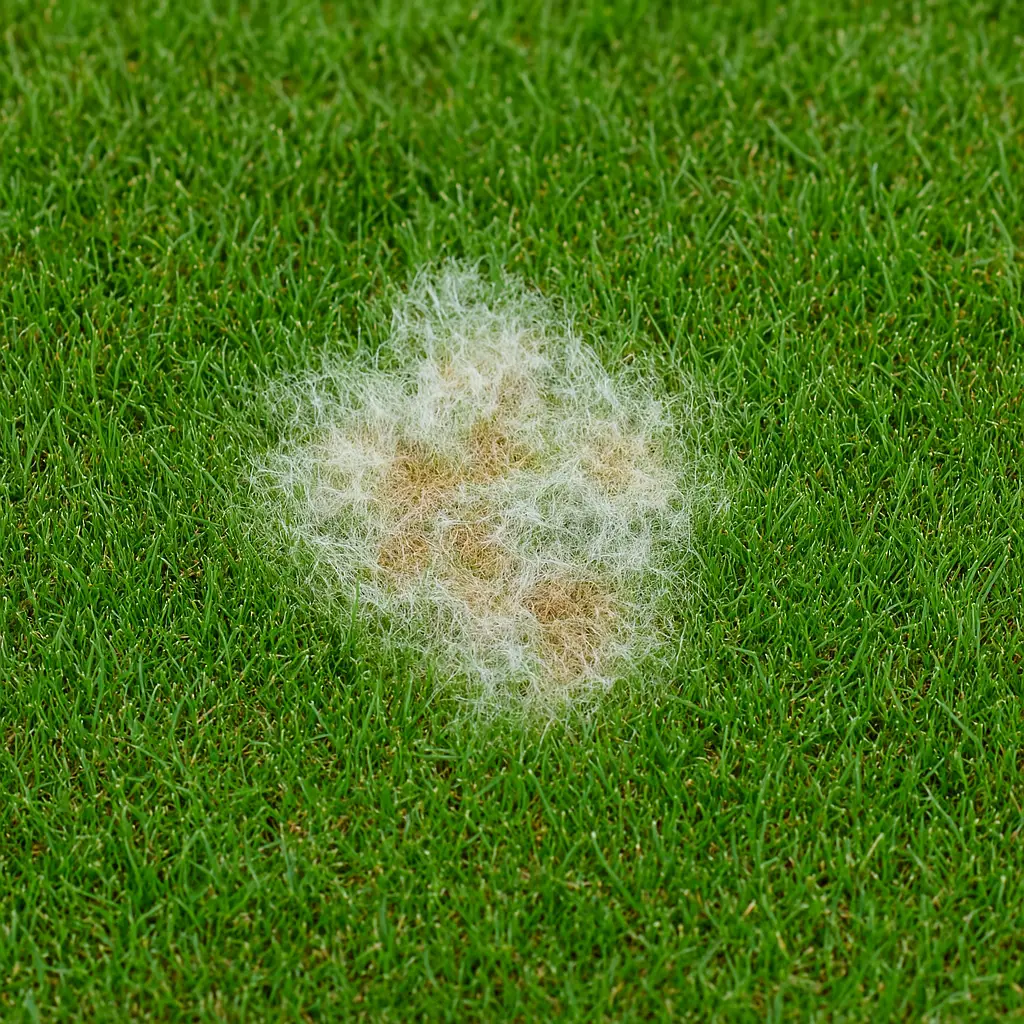 Pythium Blight: Rapid-Spread Danger in Hot, Humid Conditions
Pythium Blight: Rapid-Spread Danger in Hot, Humid Conditions